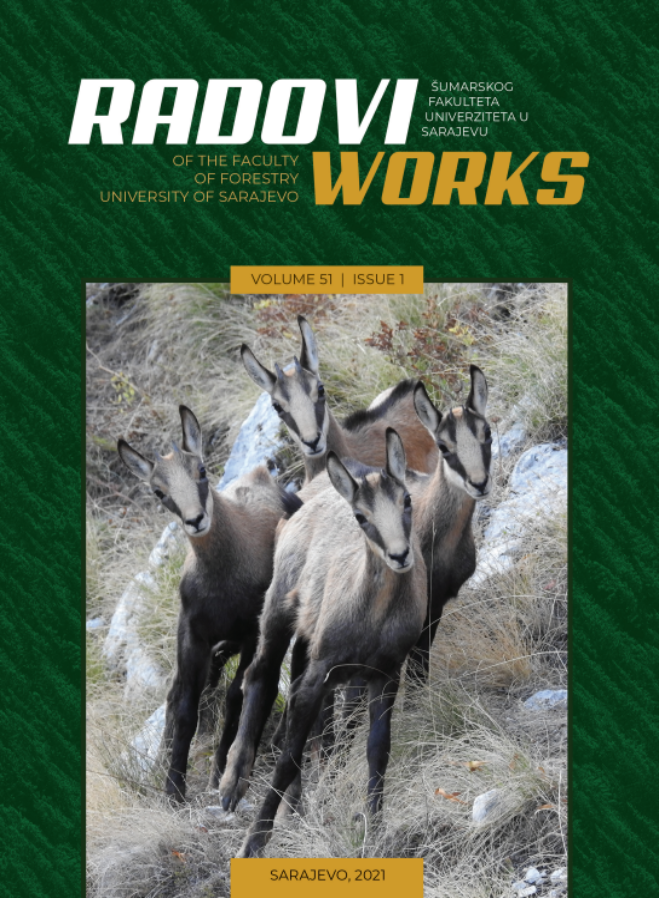Kvalitet i zdravstveno stanje sadnog materijala u rasadnicima u Bosni i Hercegovini
DOI:
https://doi.org/10.54652/rsf.2021.v51.i1.352Sažetak
Kvalitet sadnog materijala ispoljava se u vidu morfoloških i fizioloških pokazatelja, kao i u vidu pojave određenih simptoma štetnog djelovanja abiotskih i biotskih faktora. Ti pokazatelji predstavljaju rezultat zajedničkog dejstva velikog broja faktora. Sa ciljem prikaza kvaliteta i zdravstvenog stanja sadnog materijala uzeti su podaci o kvalitetu sadnog materijala i njihovom zdravstvenom stanju iz četiri rasadnika sa područja Federacije BiH: rasadnik „Ajdinovići i Glog“ Olovo, „Potklečko polje“ Zavidovići, „Pržine“ Bosansko Grahovo i „Mihaljevac“ Cazin. Podaci o kvalitetu sadnog materijala upoređivani su između rasadnika po načinu uzgoja (lijeha i nisula), prema sortimentima (školovane i neškolovane) i prema vrsti drveća (četinari i lišćari). Rezultati su pokazali da je najveći utjecaj imao način uzgoja sadnica, gdje su sadnice uzgajane u nisula sistemu u poređenju sa sadnicama iz lijeha, bile daleko lošijeg kvaliteta. Razlog tome jeste neadekvatna primjena nisula sistema odnosno nepravilno pakovanje sadnica, gdje su sadnice postavljane preduboko, sa dijelom krošnje, što je imalo za posljedicu sušenje tog dijela a samim time i gubitak asimilacione površine, smanjenje prirasta, fiziološko slabljenje itd. Svako naredno poređenje kvaliteta sadnog materijala uslovljeno je udjelom sadnog materijala iz nisula sistema. Zdravstveno stanje sadnog materijala posljedica je djelovanja brojnih faktora, a jedan od tih faktora, kao predisponirajući jeste i gusta sjetva, što je za posljedicu imalo nepovoljan odnos prečnika na vratu korijena i visine nadzemnog dijela. Posljedica zajedničkog djelovanja tih faktora jeste pojava i brojnih fitopatoloških gljiva i raznih štetnika.
Downloads
References
Bartsch N, von Lüpke B, Röhrig E (2020): Waldbau auf ökologischer Grundlage. 8. Auflage. UTB 8310. Ulmer, Stuttgart, str. 676
Dale, V.H., Joyce, L.A., Mcnulty, S., Neilson, R.P., Ayres, M.P., Flannigan, M.D., Hanson, P.J., Irland, L.C., Lugo, A.E., Peterson, C.J., Simberloff, D., Swanson, F.J., Stocks, B.J. & Wotton, B.M. (2001): Climate change and forest disturbances. Bioscience 51(9): str. 723–734.
Dautbašić, M. (2000): Štetni insekti u šumskim rasadnicima u Federaciji Bosne i Hercegovine. Savjetovanje „Sjemensko-rasadnička proizvodnja u šumarstvu BiH – stanje i perspektive“, Brčko, Zbornik radova, str. 123-126.
Dautbašić, M., Mujezinović, O., Zahirović, K. (2018): Priručnik za zatštitu šuma u Bosni i Hercegovini. Šumarski fakultet Univerziteta u Sarajevu, Sarajevo, str. 1-10.
Glavaš, M. (2003): Zdravstveno stanje biljaka i mjere zaštite u šumskim rasadnicima u Hrvatskoj u 2002. godini. Šumarski list br. (127) 5-6, str. 257-268.
Glavaš, M., Glavaš, S., Budišćak, M. I Vukadin A. (2009): Štetočine i zaštita biljaka u rasadniku „Podbadanj“ od 1993. do 2007. godine. Šumarski list br. (133) 11-12, str. 623-628
Grossnickle, S. C., & MacDonald, J. E. (2018). Seedling quality: history, application, and plant attributes. Forests, 9(5), str. 283.
Hindija, N. (2006): Primjena herbicida na najzastupljenije korovske vrste u rasadnicima šumskih i ukrasnih sadnica. Zbornik rezimea, III Simpozijum o zaštiti bilja u Bosni i Hercegovini, Neum, 13-15. decembar 2006. godine.
Imamović, M. (2019): Praćenje stanja šumskog sadnog materijala rasadnika Sedrenik, završni rad II ciklusa studija, Šumarski fakultet Univerziteta u Sarajevu, Sarajevo, str.1-44.
Lazarev, V. (2000): Biotički uzročnici šteta u rasadnicima RS i mjere zaštite. Sjemenskorasadnička proizvodnja u BiH – Stanje i perspektive. Brčko, str: 117-122.
Lazarev, V., Karadžic, D., Marković, M., Pap, P. And Poljaković-Pajnik, L. (2007): The Most Frequent Lophodermium spp. on Scots Pine and Austrian Pine and Their Role in the Appearance of Other Fungi on the Needles. Acta Silv. Lign. Hung., Spec. Edition, str. 53-59.
Lilja, A., Lilja, S., Kurkela, T. And Rikala, R. (1997): Nursery practices and management of fungal diseases in forest nurseries in Finland. A review. Silva Fennica 31(1), str. 79-100.
Lilja, A., Poteri, M., Petäistö, R.-L., Rikala, R., Kurkela, T. And Kasanen, R. (2010): Fungal diseases in forest nurseries in Finland. Silva Fennica 44(3), str. 525–545.
Liović, B. (2011): Utjecaj pepelnice (Microsphaera alphitoides Grift. et Maubl.) na rast i preživljenje hrastova ponika. Šumarski list (135) poseban broj, str. 122-129.
Liović, B. I Županić, M. (2006): Ispitivanje djelotvornosti fungicida za suzbijanje gljive Microsphaera alphitoides Griff et Maubl. na hrstovom pomlatku. Rad. Šumar. inst. Izvanredno izdanje 9, str. 181–188.
Opalički, K. (1992): Primjena FFS u Hrvatskoj tijekom 1990. godine. Šumarski list br. (116) 6-8, str. 283-289.
Papaik, M.J. & Canham, C.D. (2006): Species resistance and community response to wind disturbance regimes in northern temperate forests. Journal of Ecology 94(5), str. 1011–1026.
Pašić, M. (1985): Prilog poznavanju uzročnika polijeganja ponika u šumskim rasadnicima SR BIH. Šumarstvo i prerada drveta, Sarajevo br. 7-9, str: 257-396.
Pešková, V., Soukup, F. And Kapitola, P. (2007): Biotic damaging agents in forest nurseries in the Czech Republic. In. Diseases and insects in forest nurseries - The sixth meeting of the IUFRO Working Party 7.03.04. Editors: J. R. Sutherland, Z. Procházková. Communicationes Instituti Forestalis Bohemicae, Vol. 23, str. 138.
Poteri, M., A. Lilja, A. And Petäistö, R.-L. (2005): Control of nursery diseases and pests in Finnish forest tree nurseries. Working Papers of the Finnish Forest Research Institute 11, str. 19-26.
Schmidt, H. (1961): Die Guetebeurteilung von Forstpflanzen. Die Entwicklung von Forstpflanzen in Abhaengigkeit von Erbgut und Umwelt und die Moeglichkeiten einer Guetebeurteilung, BLV Verlagsgesellschaft München, str. 171.
Schmidt, H. (1984): Waldbau – grundlagen, Skript zur Vorlesung, Forstliche Fachschaft, Freiburg.
Treštić, T., Mujezinović, O., Osmić, S. (2013): Upotreba pesticida u šumskim rasadnicima na području Federacije Bosne i Hercegovine, Works of the Faculty of Forestry, University of Sarajevo, Sarajevo, No. 2 (13-26), str. 13-16.
Ulanova, N.G. (2000): The effects of windthrow on forests at different spatial scales: a review. Forest Ecology and Management 135(1–3): str. 155–167.
Usčuplić, M., Treštić, T. (2000): Bolesti sjemena i sadnica u šumskim rasadnicima. Savjetovanje „Sjemensko-rasadnička proizvodnja u šumarstvu BiH – stanje i perspektive“, Brčko, Zbornik radova, str. 113-116.
Vasic, V., Konstantinovic, B. and Orlovic, S. (2012): Weeds in Forestry and Possibilities of Their Control. In: Weed Control. Edited by Andrew J. Price, Publisher: InTech, Chapters published February 29, 2012 under CC BY 3.0 license.ISBN 978-953-51-0159-8, str. 276,
Višnjić, Ć. (2012): Analiza kvaliteta sadnog materijala za potrebe šumarstva u rasadnicima Federacije Bosne i Hercegovine, Naše šume, No 28-29, str. 4-11























